

Joyce’s Galway Bank, was registered on 30 October 1802 by Walter Joyce, with Mark Lynch as junior partner.
Lynch left in 1807 to set up a separate bank under the name Mark Lynch and Son. Around the same time, Walter Joyce retired after his brother in law, John Appleyard, became a partner. John Joyce appears to have exited the bank in 1807 (an 1807 note lists Walter Joyce & John Appleyard as partners) only to return when Walter Joyce retired.
When Appleyard died, Francis Blake replaced him as junior partner in the business. The bank became known thereafter as John Joyce and Co.
It is not clear when the bank actually closed. It seems likely that the bank failed in the fall out surrounding the collapse of Ffrench’s Bank in June 1814 which seriously weakened confidence in the banking system in the west of Ireland. Lynch's Galway Bank also failed in 1815, likely for the same reason.
The bank closed after a sustained run on it over a two week period during which it is stated to have paid out nearly £200,000. This would suggest that Joyce’s bank was in relatively good shape prior to the failure of Ffrench’s and the subsequent shock to the regional banking system.
Joyce appears to have cooperated with the creditors with the sale of around £7,000 worth of his own property to put towards his bank’s debts. It is recorded that he was a highly reputable person [1. Dutton, 1824, p. 418].
By 1824 around half of the bank’s debts had been paid [Dutton, p. 418]. Final settlement of the bank's debts dragged out long after the its failure, as the proceedings were still in the courts as late as 1888.
The latest date recorded is on a One Guinea note, dated 1 Dec 1813. Surviving banknotes are quite scarce, suggesting that a substantial amount of the outstanding notes were eventually redeemed.
Examples of banknotes and post bills are known. Notes of the banks are quite scarce, with eariler notes of Types A to C being rare.
Four Series of notes known for Joyce's Bank, including Exchange Bills
There are four Series known by design as illustrated below, and five Types by partnership. Other series are possible.
Five Types by partnership, as seen on notes.
Type A. 1804-1806. Walter Joyce, Mark Lynch.
Type B. 1806. Walter Joyce, John Joyce. (Recorded on an exchange bill).
Type C. 1807. Walter Joyce, John Appleyard.
Type D. 1810. John Joyce, John Appleyard.
Type E1. 1810-1814. John Joyce, Fran's Blake. Seen on banknotes only.
Type E2. 1810-1814. John Joyce, Francis Blake. Seen on post bills only.
Denominations recorded: 1 Guinea, 3 Guineas, 6 Shillings, £1, 25 Shillings, 30 Shillings. Others likely.
Printers: unknown.
Note issues of Joyce's Bank, Galway
All banknotes were printed uniface. Joyce's bank issued banknotes and post bills.
On Type E banknotes, the name of the second partner, Francis Blake is abbreviated to Fran's Blake, while it is spelt in full on Post Bills of Type E.
Joyce's bank used the family arms of the partners as its symbol. Two varieties of the bank symbol were used on banknotes. Initially, the arms of both Joyce and Lynch appeared on the notes. This would suggest a certain degree of equality between the two partners.
When Lynch left the partnership, this was reflected in the note designs by altering the bank symbol to an amended design of just the Joyce arms. This symbol appeared on all subsequent banknotes and post bills.

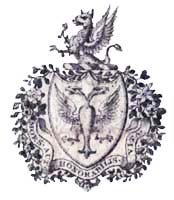
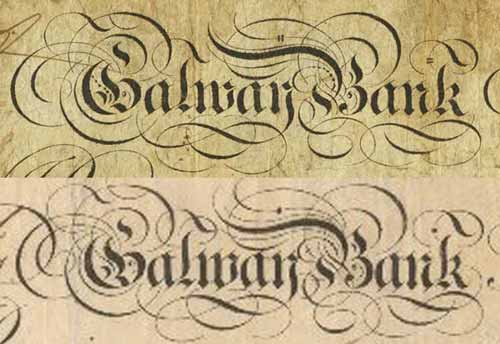
An interesting observation is that the engraving of 'Galway Bank' on some notes of Lynch's bank, dated 1813 is very similar to that on some of the notes printed for Joyce's bank, illustrated above. The engraving on top is from an unissued 30 Shilling Joyce's note of the Joyce, Blake partnership, it is used also on issued Series 4D One Guinea notes, dated in 1813. On the engraving below it is from an issued Lynch's note for One Guinea and Half, issued in 1813, but printed before 1810.
Whether this design similarity indicates that the printers were reusing elements of the printing plates for each bank, or that there might have been some kind of co-operation between the two banks remains to be investigated. Other elements of these banknote designs are not as similar.
30 Shilling notes of a different design dated in 1813 have been recorded from the Joyce-Blake partnership.
This similarity between notes of Joyce's and Lynch's banks has lead to some confusion over the years among collectors of the banknotes as to the differences between the two banks.
Series 1, Type A
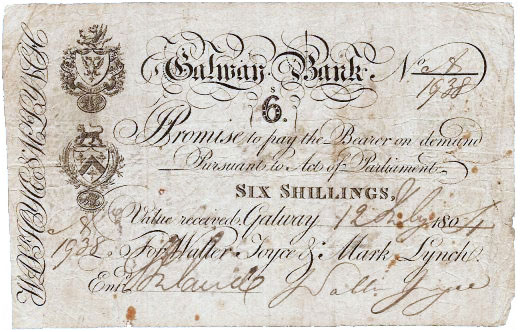
Galway Bank, Walter Joyce and Mark Lynch, 6 Shillings, 12 July 1804
[2. ex Whytes, 2001, Lot 313]
Series 2, Type B

Galway Bank, Walter Joyce and John Joyce, Exchange Bill, 22nd October 1806 for £40, payable to John Roche
John Roche appears to have been a major Dublin merchant of the time. Bills of exchange were were transferable by endorsement and circulated as currency. E. Wakefield in an 1810 report to the Bullion Committee makes the following comment: 'Bills of exchange greatly aid transfers, and supply the place of circulating medium, especially those drawn on Dublin, which pass from hand to hand until they fall due.'
Series 2, Type C
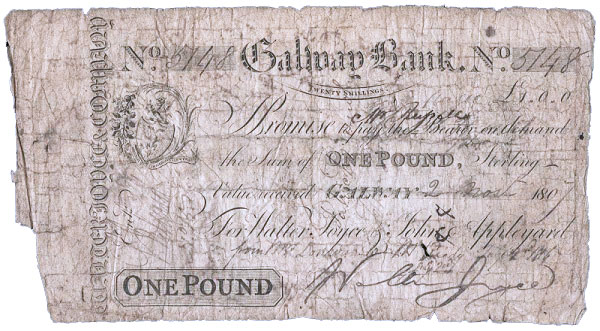
Galway Bank, Walter Joyce and John Appleyard, One Pound, 2nd November 1807
[8. ex Noonan's (DNW), 29 Sept 2011, Lot 4361]
Type D
No notes available for illustration
Series 3, Type E
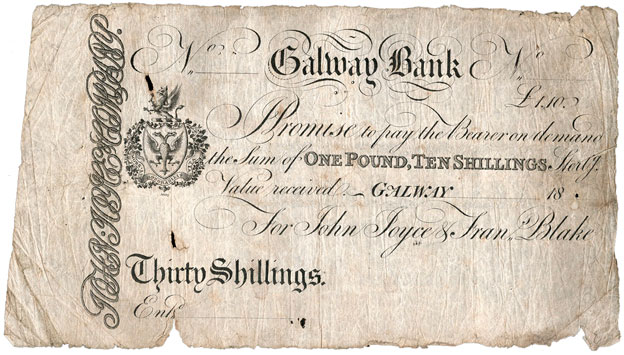
Joyce's Bank, Galway. 30 Shillings unissued. John Joyce, Francis Blake, 1810-1814
[3. ex Noonan's (DNW), 2 Oct 2008, Lot 18; 24 Oct 2012, Lot 292]
Series 3, Type E2, Post Bills
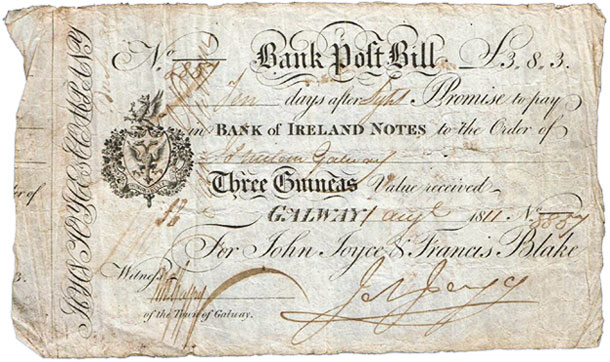
Joyce's Galway Bank. Post Bill, 3 Guineas, John Joyce, Francis Blake, 1 Aug 1811. No. 8857
[4. ex Whyte's, 3 Feb 2018, Lot 381]
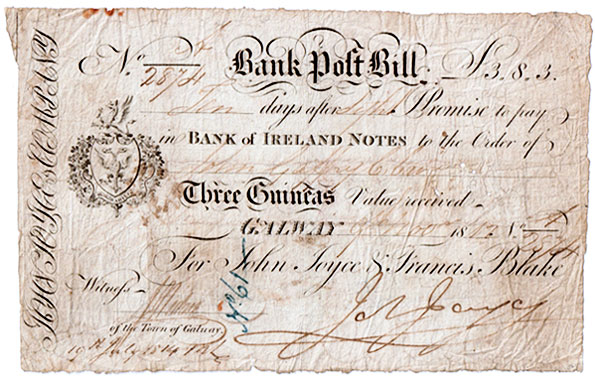
Joyce's Galway Bank. Post Bill, 3 Guineas. John Joyce, Francis Blake 1812. No. A 2874
This note has a date annotation on the bottom left, 19th July 1814, which it is believed is after the bank failed. This might be an indication of the note's redemption date, though the note itself does not appear to be cancelled. Interesting.
[5. ex Whyte's, 9 Mar 2014, Lot 783]
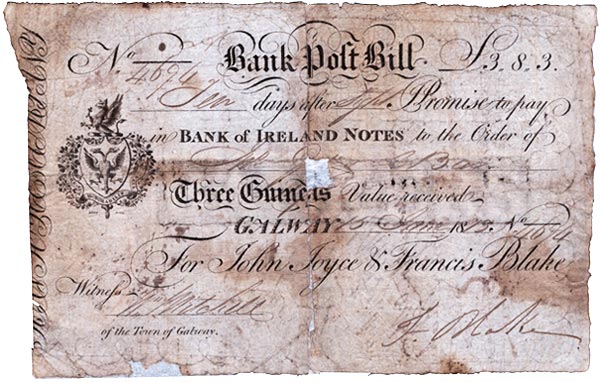
Joyce's Galway Bank. Post Bill, 3 Guineas. John Joyce, Francis Blake, 15 June 1813. No. A 4694
These Three Guinea Post Bills are the only notes seen where the first name of the second partner Francis Blake is not abbreviated.
[6. ex Noonan's (DNW), 24 Oct 2012, Lot 355]
Series 4, Type D
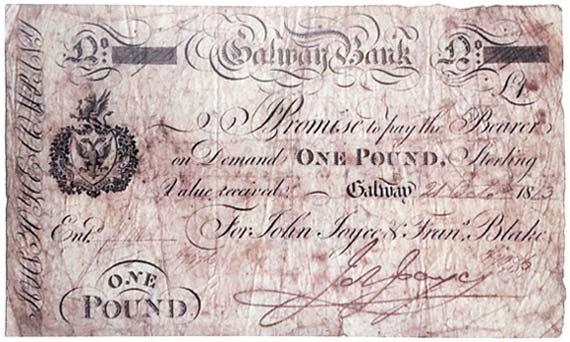
Joyce's Galway Bank. One Pound, 21st Oct 1813

Joyce's Galway Bank. One guinea, 1st Dec 1813
[2. ex Whytes, 2001, Lot 325]
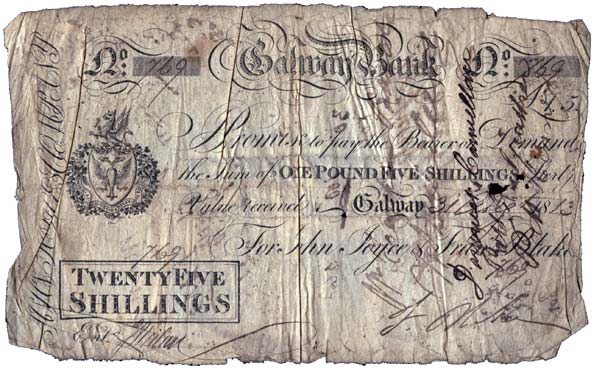
Joyce's Bank, Galway. 25 Shillings, 1813
[7. ex Noonan's (DNW), 7 Dec 2015, Lot 174]
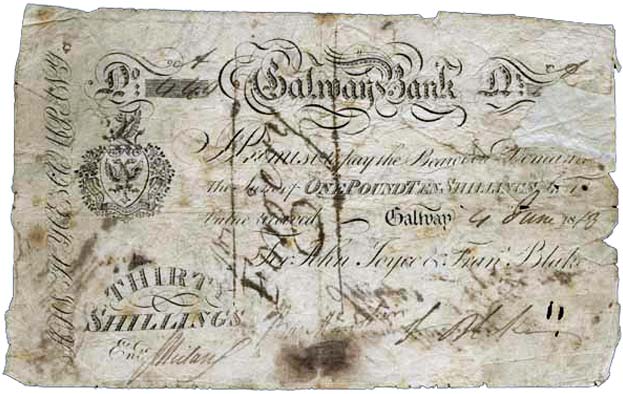
Joyce's Bank, Galway. 30 Shillings, 4th June 1813. Contemporary forgery
[3. ex Noonan's (DNW), 2 Oct 2008, Lot 19; 24 Oct 2012, Lot 292]
References
1. Dutton, H. (1824). A statistical and agricultural survey of the county of Galway. Dublin: Graisberry, pp. 417-419.
2. Auction Catalogue, Whytes, Dublin. Coins, Banknotes, Medals & Militaria, 23 February, 2001.
3. Auction Catalogue, Noonan's (DNW), London. Important Collection of Irish Paper Money formed by Bob Blake (Part I), 2 Oct 2008.
4. Auction Catalogue, Whytes, Dublin. The Eclectic Collector, 3 February, 2018.
5. Auction Catalogue, Whytes, Dublin. History, Literature and Collectibles, 9 March, 2014.
6. Auction Catalogue, Noonan's (DNW), London. British and World Paper Money, 24 Oct 2012.
7. Auction Catalogue, Noonan's (DNW), London. Coins, Tokens, Historical Medals and Paper Money, 7 Dec 2015.
8. Auction Catalogue, Noonan's (DNW), London. British and World Paper Money, 29 Sept 2011.